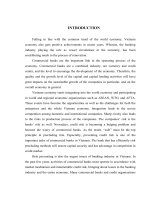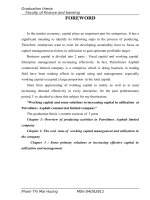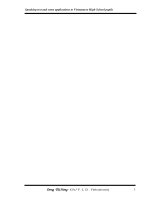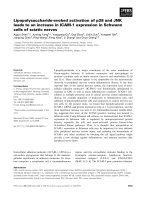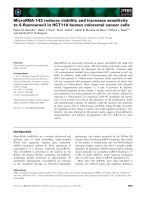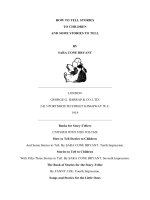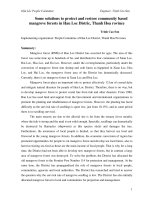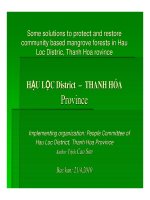Working capital and some solutions to increasing capital in utilization at Petrolimex Asphalt commercial limited company
Bạn đang xem bản rút gọn của tài liệu. Xem và tải ngay bản đầy đủ của tài liệu tại đây (223.92 KB, 28 trang )
Graduation thesis Faculty of finance and banking
FOREWORD
In the market economy, capital plays an important part for enterprises. It has a
significant meaning to identify its following steps in the process of producing.
Therefore, enterprises want to exist for developing sustainably have to focus on
capital management activities in utilization to gain optimum profitable target.
Business capital is divided into 2 parts : Fixed capital and working capital.
Enterprise management in increasing effectively. In fact, Petrrolimex Asphalt
commercial limited company is a enterprise which is doing business in trading
field have been making efforts in capital using and management, especially
working capital occupied a large proportion in the total capital.
Stem from appreciating of working capital in reality as well as to meet
increasing demand effectively in every enterprise, for the past probrationary
period, I`ve decided to chose this subject for my thesistation.
“Working capital and some solutions to increasing capital in utilization at
Petrolimex Asphalt commercial limited company”
The graduation thesis`s content consists of 3 parts
Chapter 1: Overview of producing activities in Petrolimex Asphalt limited
company
Chapter 2: The real state of working capital management and utilization in
the company
Chapter 3 : Some primary solutions to increasing effective capital in utilization
and management
Pham Thi Mai Huong MSV:04D02811
Graduation thesis Faculty of finance and banking
CHAPTER 1
THEORY OF WORKING CAPITAL AND ITS EFFECTIVE
UTILIZATION IN ENTERPRISE
1. Theory of working capital
1.1. The notion of working capital
Any enterprise wants to carry out its produce and business process, it needs a
combination of 3 factors : labour force, tools and materials
Difference between tools for working and materials for working (materials,
fuels, semi- unfinished products …). It only take part in one producing process
and does not come back its initial form, all its value will change into in product`s
value.
Materials for working : as in kind form it is called working assets. As for
value form, it is called Working capital of enterprise.
Working Assets included : Working assets for manufactoring and working
capital for circulating.
Working Assets for manufactoring included such as : raw materials, fuels,
materials, alternative accessories, half of products, unfinished products … are all
being in process of reserve or manufactoring.
Working Assets for circulating included : finished products are waiting for
consumption, capitals in cash, capitals in payment, prepaid costs … In producing
and businessing process, working Assets fo manufactoring and working assets for
circulating are always mobilising, transforming to each other and at last aiming to
ensure non-stop produce and business process.
It is also an expressed form of working assets, so the characters of working
capital exercises are always affected by working assets`s characters. Working
capital will be transformed and repeated consecutively. So, they will create
repeated cycle of working capital. One cycle starts since investing capital under
the monetory form then finishing at the production cycle to come back its initial
state.
Pham Thi Mai Huong MSV:04D02811
Graduation thesis Faculty of finance and banking
To the manufacture enterprises, the cycle of working capital process always
mobilises under the following formula :
TLSX
T-H … SX … H’- T’
SLĐ
For commercial enterprises, the repeated cycle of working capital process
always mobilises under the following formula :
T – H – T’
Therefore, Working capital is under the monetory, it is an expressed form of
working capital or in other words, it is monetory on prepaid account to take shape
of working assets for producing and working assets for circulating to ensure
process of produce and business are going on smoothy.
1.2.Working capital and the classification
1.2.1. The classification under expressed form
According to the classification, working capital is divided into 2 parts :
- Capital in cash and accounts receivable : It consists of monetory in funds,
bank`s deposit, capital in payment, short-term investment in securities …
- Capital in materials, goods : They are working capitals which are under the
expressed forms such as raw materials and materials, unfinished products, half of
finished products, finished products …
The classification will help enterprises to evaluate the level of inventory and
ability of payment.
1.2.2. The classification under the working capital`s role in produce and business
process
Under the classification, working capital are divided into 3 parts :
- Working capital in producing reserved : Including of prime materials, sub
materials, fuels, alternative marterials, tools.
- Working capital in producing process : Value of unfinished products, semi-
finished products and other costs.
Pham Thi Mai Huong MSV:04D02811
Graduation thesis Faculty of finance and banking
- Working capital in circulating process : Value of finished products, capital
in cash, short-term investment, mortgages, pay a security, pay earnest money in
short-term and accounts capital in payment.
1.3. Working capital`s structure and driving factors behind
There are many factors that have influences on capital`s structure, including many
parts. There can be divided into 3 main groups below :
- The factors related to supply materials such as : The distance between
enterprise and supplier places, market and ability of supply materials, material
prices, the scale of production.
- The factors related to production : Character, technology, producing
technology of the enterprise, the complexion of produced products, the lengh of
produce cycle, the level ability of producing process organization, professional
skills of Workers.
- The factors related to payment method : payment methods and the
execution of payment principles between enterprises.
1.4. Working capital resources
1.4.1. The classification with the relation of ownership
According to the classification, it is divided into 2 parts :
- Loan Accounts : It is the capital resource of borrowing from commercial banks or
financial organizations, Customer ccounts receivable....enterprise is entitled to use
them in a given temporary .
- Owner`s equity : This is account capital which is under enteprise ownership,
including
* Mobilised capital inside : left benefit, funds.
* Mobilised capital outside : From the members of enterpsie, joint-venture
capital , State budget capital, Share capital is mobilised by issuing shares to the
public.
Pham Thi Mai Huong MSV:04D02811
Graduation thesis Faculty of finance and banking
1.4.2. Classification of working capital follwoing to mobilising time and
utilization methods
According to the norm, enterprises`working capital included : regular capital
and current capital.
- Regular capital : Including the Owner`s equity and long-term debts. The
capita is stable and can use for along time. Enterprises use it for investment,
buying Fixed assets or using all or part of regular working capital which is
necessary for business activities.
- Current capital : Including of short-term loans from banks and other credit
organizations, long-term debts fall due, Accounts receivable from suppliers,
Accounts payable for workers, Accounts payable for the State budget … This is
short term capital that enterprise can use it to meet the temporary working capital
demand in produce and business activities.
The classification will help managers to evaluate the mobilised capital which
is suitable to quality and in the time to use necessary factors for business activities.
1.5.Working capital demand and the driving factors behind
Working capital demand always changes and depend on many factors. In
there, we need to care about following the fomula and the main factors :
- The factors related to Business features such as : Business period, Business
scale, it is temporary Business activities, The changes of producing technology …
Pham Thi Mai Huong MSV:04D02811
Working
capital
demand
= Inventories +
Custo
mer accounts
receivable
-
Suppli
ers accounts
prepaid
Graduation thesis Faculty of finance and banking
The factors have affected directly to the level of working capital that enterprise has
to meet the prepaid capital with a required time demand.
- The factors related to buy materials and product consumption :
+The distance between enterprises and sppliers.
+ The fluctuations of goods and material costs which are being used in
produce and business of the enterprises.
+ The gap between enterprises and selling market .
+ Conditions and means of transportation …
- Enterprise`s policies in consumption activities and credit with payment
organization impact on payment term and scale of Accounts receivable.
Consumption activities organization and carry out the payment activities
organization of selling goods have strongly affected to enterprise`s working capital
demand.
2. Working capital and its importance in increasingly effective
utilization.
2.1. Working capital and norms to reflect its cycle speed
2.1.1. Payment ratios
* Short-term debts payment ratio
It is the relation between short-term assets and short-term debts ( including:
short-term debts in term and long-term debts fall due ).
Value of current aassets
The current ratio = –––––––––––––––––––––––––––
Short-term debts
This ratio assesses changeable ability of short-term assets into cash in order to
pay Short-term debts in term of Enterprises.
Short term Assets = Inventories + Cash and equivalent + Accounts receivable.
Among them, Inventories is a part of working capital which has the lowest
ability to change into monetory.
Pham Thi Mai Huong MSV:04D02811
Graduation thesis Faculty of finance and banking
* Quick ratio
Value of current assets – Value of Inventories
The quick ratio = –––––––––––––––––––––––––––––––––
Short-term debts
This ratio reflects accounts debts in the fastest time.This ratio provides
information regarding the firm`s liquidity and ability to meet its obligations. It
indicates a company financial strenghts (or weaknesses) but this ratio can be good
or bad, this depends on character of every business field.
* Current ratio
Cash and cash equivalent
The cash ratio = –––––––––––––––––––––––––––––––––
Short-term debts
The current ratio measures whether or not a firm has enough resources to pay its
debts over the nest 12 moths. It compares a firm`s current assets to its current
liabilities.
A comparison with the industry of the firm`s current ratio, and a comparison
with average, can help determine if the current ratio is high or low at this period in
the time`s comparison. These comparisons do not indicate why the current ratio is
higher or lower than industry. For some possible reasons of the current ratio is out
of line, which can be found from analysis of the individuals account that has been
usually performed for Accounts receivable and Inventories.
2.1.2. The number of Inventory cycle
The number of inventory cycle are the times of average inventory, which is
mobilised in term.
Costs of goods sold
The number of Inventories cycle = ––––––––––––––––––––––––
Average Inventories
Pham Thi Mai Huong MSV:04D02811
Graduation thesis Faculty of finance and banking
The number of inventory cycles are more and more higher, the business will
be better because enterprises only need to invest a small level of Inventories but
they still achieve a high turnover.
2.1.3.The number of accounts receivable cycle
The norm reflects ability of capital recovery for payment in enterprises
Accounts receivable
cycle
=
Net Sales
Remainder average Accounts receivable
The cycle is more higher, the more better. It proves that the fast speed of
recovery of Accounts receivable. Enterprises will needn`t to invest too much in
Accounts receivable.
2.2.The primary factors have influences on the utilization effects of working
capital
* Objective factors
+ Fluctuations of economy : If economy with its inflation causes the rising
of goods prices, including input material costs, produce costs will grow, product
prices will be raised and of course to make the consumption will become
ineffciently.
+ The non-stop development of Science and Technology also contribute to
increasing effecient utilization of working capital. Science and technology are
developing that it can be helpful factors or can be adverse factors to enterprise. if
enterprise produces redundant products and they can not be consumed. Therefore
this will be negative factors.
+ Business environment : The number of rising competitors, alternative
products, changed market demand … They will impact on the ability of
consumption, even though leading to the situation of capital losing.
Pham Thi Mai Huong MSV:04D02811
Graduation thesis Faculty of finance and banking
+ The State with marcro policies : The state`s policies are very important to
enterprises` operations. In each policy has 2 effects, may be positive and may be
not positive to Business activities in their fieds.
* Subjective factors
+ We can recognize enterprises` weak points in quality of management. It
causes the redundant or shortage of capital.
+ Ability of penertration and enlargement the market of enterprise : the
speed of consumptionis better, the Working capital is higher, therefore its efficient
in utilization will grow.
2.3. some solutions aiming to increase the utilization effects of working capital
2.3.1. Secification of the level necessary working capital demand for business
operation
Specification of necessary Working capital regularly, this will ensure the level
enough capital to meet the demand of Business process amd avoid unliquided
capital or short of capital, leading to interrupted production situation.
Business activities have to ask for capital to come into operation. When starting to
produce and do business, enterprise has to calculate the level of necessary capital
demand and one of the most important is that enterprise has to calculate accurately
in line with developing period in general and in produce process in particular.
Because of this will help enterprise`s business operation go on smoothy and
efficiently.
2.3.2. To push up the working capital` s rotate speed highly
The effects of Working capital are evaluated by its rotate speed. If Working
capital has a highly rotated speed, it shows that the effect of working capital
utilization is very good. So, it is necessary to hasten speed of liquided Working
capital in 3 processes : reserve , produce and circulation.
2.3.3. Carry out of checking, analysing, surpervising Business activities tightly
and regulary.
Pham Thi Mai Huong MSV:04D02811
Graduation thesis Faculty of finance and banking
Executing of check activities regularly and consecutively will help
enterprises to evaluate their strong points and weak points. Steming from there,
enterprises can develop their advantages or prevent and modify shortcomings in
time.
Chapter 2
OVERVIEW OF PRODUCE ACTIVITIES IN PETROLIMEX
ASPHALT LIMITED COMPANY
1. Introduction
1.1. Some information about the company
Enterprise name : Petrolimex Asphalt commercial limited company
Short name : Petrolimex Asphalt co.,LTD
Headquarters : At 1 Kham Thien _Dong Da district _ Ha Noi
Petrolimex asphalt commercial limited company, to be a subsidiary of
Petrolimex Petrochemical - a member of Viet Nam Petrolimex, head of
company. The company specialises in business with products related to
asphalt in domestic market and regional South East Asia countries.
In order to meet the increasing demand of petrolimex asphalt products in the
domestic market. The ministry of Trading officially approved the company became
as a member of Petrolimex Petrochemical joint stock company and under the name
of Petrolimex Asphalt commercial limited company. The company deloyed “under
the model of parents _subsidiary company ”.
PLC is one of the most dynamic members of Petrolimex Petrochemical and
approved by the ministry of Trading.
Presently, the company is representative partner of BPETCO to supply high
quality products of BP on market. It has been the first doing business with 60/70
hot solid asphalt products in Viet Nam since 1997
1.2. Business sectors and main products
Do business sectors
Pham Thi Mai Huong MSV:04D02811
Graduation thesis Faculty of finance and banking
Do business with import and export petrolimex Asphalt products, in the short term,
concluded 3 main sectors : lubricant , chemical, asphalt fields and some sectors
related to them.
- Doing business with import and export material products, Asphalt
equipments.
- Doing business with services related to : Shipping, stocks, mixtrure,
alnalysis, consultancy and technical services.
- In the coming time, the company will take part in doing business with
buildings and real estate.
Main products : Asphalt, chemical, lubricant.
1.3. Organization of management
Management` structure : Including, chairman, director, duty director .
- Chairman: cotrol Business activities as well as making regulations, priciples
and the organization model and and have the authority to appoint director of
Petrolimex Asphalt limited company.
- Director : Director is a person who is resposible for Business operations to
chairman and directly running Business activities and has to report them to
chairman.
- Duty director : Duty is a person who is intitled to help director and along with
director to run Business operations and to take the regulations and priciples of
mother company given into practice. Duty director is also responsiblity to director
and chairman for given responsibility.
1.4. Accounting`s structure
Accounting department : responsible to financial accounting activities to
director. Always updating and giving accurated figures in time. The department
has to give balance sheet, financial report … calculate expensives such as : profits,
make loss, taxes, salary, bonus, other policies for staffs.
At the being time, Accounting department has 9 people concluded : 1 chief
accountant, 2 deputy chief accountants and 6 accountants (accountant take
Pham Thi Mai Huong MSV:04D02811
